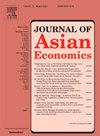The impact of cross-border capital flows macro-prudential management policy on bank credit
IF 2.9
3区 经济学
Q1 ECONOMICS
引用次数: 0
Abstract
This study examines the impact of cross-border capital flow-oriented macro-prudential policies (MPPs) on banking credit dynamics through a quasi-natural experiment encompassing 110 countries from 2000 to 2020. The findings reveal that MPPs significantly mitigate banking credit growth, with more pronounced effects during the post-financial-crisis period. These policies act through commodity prices and exchange rate movements by tempering capital inflows, thereby reducing excessive credit expansion and curbing systemic financial risks. The efficacy of MPPs is critically shaped by regulatory frameworks, the degree of economic liberalization, and the concentration dynamics within banking sectors, collectively underscoring the indispensable role of institutional robustness and competitive market mechanisms in policy implementation. Furthermore, the study uncovers an asymmetrical policy impact, with MPPs demonstrating enhanced efficacy in countries characterized by more advanced financial development. These results have significant policy implications, emphasizing the strategic value of targeted macro-prudential measures in three crucial areas: stabilizing credit cycles, enhancing financial system resilience, and preventing the cross-border contagion of financial vulnerabilities.
跨境资本流动宏观审慎管理政策对银行信贷的影响
本研究通过2000年至2020年涵盖110个国家的准自然实验,考察了跨境资本流动导向的宏观审慎政策(mpp)对银行信贷动态的影响。研究结果表明,mpp显著减缓了银行信贷增长,在后金融危机时期的影响更为明显。这些政策通过大宗商品价格和汇率变动来调节资本流入,从而减少信贷过度扩张,遏制系统性金融风险。管理框架、经济自由化程度和银行部门内部的集中动态对mpp的效力产生了关键影响,共同强调了体制的坚固性和竞争性市场机制在政策执行中不可或缺的作用。此外,该研究还揭示了一种不对称的政策影响,在金融发展更发达的国家,mpp的效力更强。这些结果具有重要的政策意义,强调了有针对性的宏观审慎措施在三个关键领域的战略价值:稳定信贷周期、增强金融体系弹性和防止金融脆弱性的跨境传染。
本文章由计算机程序翻译,如有差异,请以英文原文为准。
求助全文
约1分钟内获得全文
求助全文
来源期刊

Journal of Asian Economics
ECONOMICS-
CiteScore
4.70
自引率
9.40%
发文量
90
期刊介绍:
The Journal of Asian Economics provides a forum for publication of increasingly growing research in Asian economic studies and a unique forum for continental Asian economic studies with focus on (i) special studies in adaptive innovation paradigms in Asian economic regimes, (ii) studies relative to unique dimensions of Asian economic development paradigm, as they are investigated by researchers, (iii) comparative studies of development paradigms in other developing continents, Latin America and Africa, (iv) the emerging new pattern of comparative advantages between Asian countries and the United States and North America.
 求助内容:
求助内容: 应助结果提醒方式:
应助结果提醒方式:


